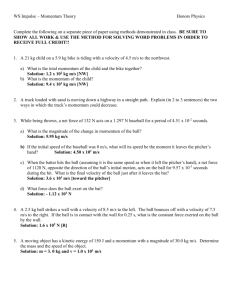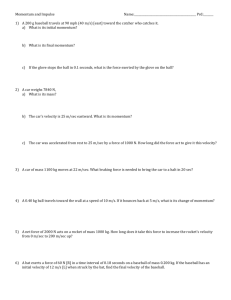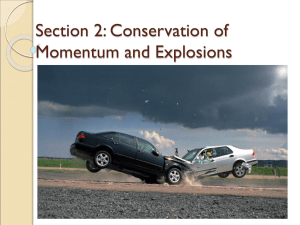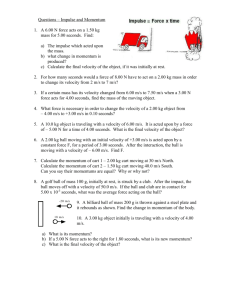practice: impulse-momentum & conservation of
advertisement
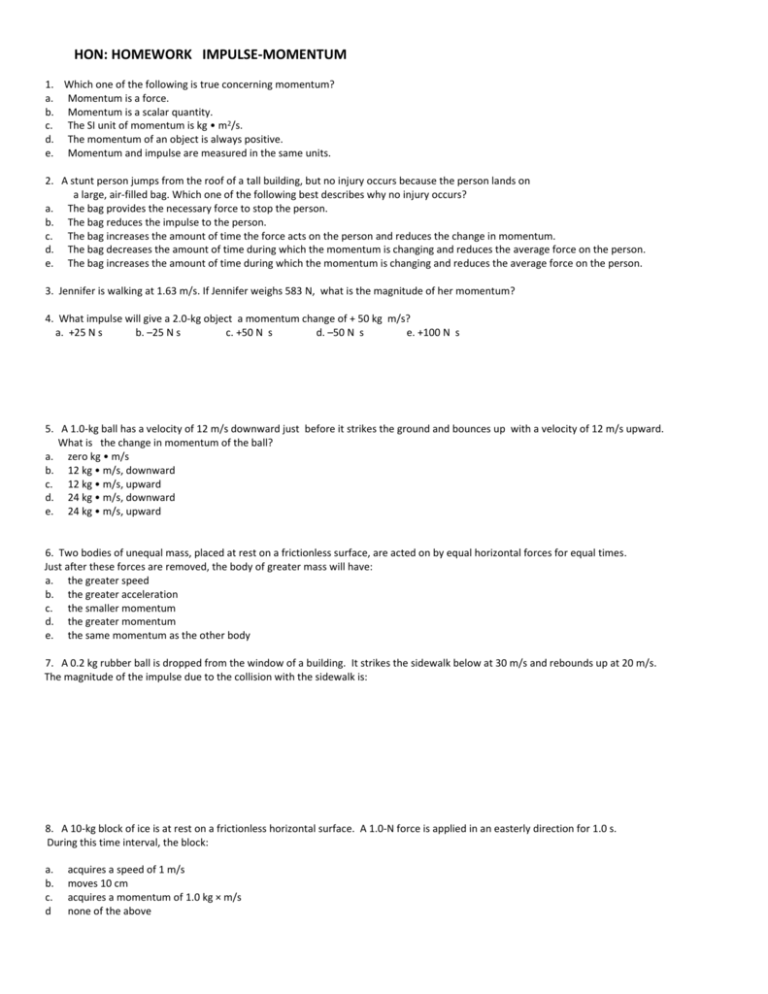
HON: HOMEWORK IMPULSE-MOMENTUM 1. Which one of the following is true concerning momentum? a. Momentum is a force. b. Momentum is a scalar quantity. c. The SI unit of momentum is kg • m2/s. d. The momentum of an object is always positive. e. Momentum and impulse are measured in the same units. 2. A stunt person jumps from the roof of a tall building, but no injury occurs because the person lands on a large, air-filled bag. Which one of the following best describes why no injury occurs? a. The bag provides the necessary force to stop the person. b. The bag reduces the impulse to the person. c. The bag increases the amount of time the force acts on the person and reduces the change in momentum. d. The bag decreases the amount of time during which the momentum is changing and reduces the average force on the person. e. The bag increases the amount of time during which the momentum is changing and reduces the average force on the person. 3. Jennifer is walking at 1.63 m/s. If Jennifer weighs 583 N, what is the magnitude of her momentum? 4. What impulse will give a 2.0-kg object a momentum change of + 50 kg m/s? a. +25 N s b. –25 N s c. +50 N s d. –50 N s e. +100 N s 5. A 1.0-kg ball has a velocity of 12 m/s downward just before it strikes the ground and bounces up with a velocity of 12 m/s upward. What is the change in momentum of the ball? a. zero kg • m/s b. 12 kg • m/s, downward c. 12 kg • m/s, upward d. 24 kg • m/s, downward e. 24 kg • m/s, upward 6. Two bodies of unequal mass, placed at rest on a frictionless surface, are acted on by equal horizontal forces for equal times. Just after these forces are removed, the body of greater mass will have: a. the greater speed b. the greater acceleration c. the smaller momentum d. the greater momentum e. the same momentum as the other body 7. A 0.2 kg rubber ball is dropped from the window of a building. It strikes the sidewalk below at 30 m/s and rebounds up at 20 m/s. The magnitude of the impulse due to the collision with the sidewalk is: 8. A 10-kg block of ice is at rest on a frictionless horizontal surface. A 1.0-N force is applied in an easterly direction for 1.0 s. During this time interval, the block: a. b. c. d acquires a speed of 1 m/s moves 10 cm acquires a momentum of 1.0 kg × m/s none of the above 9. A 0.065-kg tennis ball moving to the right with a speed of 15 m/s is struck by a tennis racket, causing it to move to the left with a speed of 15 m/s. If the ball remains in contact with the racquet for 0.020 s, what is the magnitude of the average force experienced by the ball? 10. A bat strikes a 0.050-kg baseball so that its velocity changes by +30 m/s in 0.10 s. With what average force was the ball struck? 11. A football player kicks a 0.41-kg football initially at rest; and the ball flies through the air. If the kicker's foot was in contact with the ball for 0.051 s and the ball's initial speed after the collision is 21 m/s, what was the magnitude of the average force on the football? 12. a. b. c. d. Which of the following has the greatest momentum? truck with a mass of 2250 kg moving at a velocity of 25 m/s car with a mass of 1210 kg moving at a velocity of 51 m/s truck with a mass of 6120 kg moving at a velocity of 10 m/s car with a mass of 1540 kg moving at a velocity of 38 m/s 13. What velocity must a 1340 kg car have in order to have the same momentum as a 2680 kg truck traveling at a velocity of 15 m/s to the west? 14. A force is applied to stop a moving shopping cart. Increasing the time interval over which the force is applied a. requires a greater force. c. requires a smaller force. b. has no effect on the force needed. d. requires the same force. 15. A 6.0 x 10–2 kg tennis ball moves at a velocity of 12 m/s. The ball is struck by a racket, causing it to rebound in the opposite direction at a speed of 18 m/s. What is the change in the ball’s momentum? 16. A rubber ball with a mass of 0.30 kg is dropped onto a steel plate. The ball’s velocity just before impact is 4.5 m/s and just after impact is 4.2 m/s. What is the change in the ball’s momentum? 17. A 0.2 baseball if pitched with a velocity of 40 m/s and is then batted to the pitcher with a velocity of 60 m/s. What is the magnitude of change in the ball’s momentum? 18. A ball with a mass of 0.15 kg and a velocity of 5.0 m/s strikes a wall and bounces straight back with a velocity of 3.0 m/s. What is the change in momentum of the ball? 19. Suppose that the force exerted on football of mass 0.50 kg when it is kicked varies with time as shown by the graph below. The change in its momentum is 20. A rocket is launched vertically from rest; and it burns fuel at a constant rate of 136 kg/s. Exhaust gases are expelled with a speed of 5.25 x 103 m/s relative to the rocket. What is the magnitude of the thrust? 21 . During an autunm storm, a 0.012-kg hail stone traveling at 20.0 m/s made a 0.20-cm-deep dent in the hood of Darnell’s new car. What average force did the car exert to stop the damaging hail stone? 22. A constant force of magnitude F acts on a body. The graph shows the variation with time t of the momentum p of the body. The magnitude of the force F is 23. A projectile strikes a plastic sheet at a speed of 150 ms-1. It penetrates the sheet and emerges with a speed of 50 ms−1. The initial and final momenta of the projectile are represented by the following vectors. Which one of the following vectors best represents the momentum change for the projectile? 24. The velocity of a body of mass m changes by an amount Δv in a time Δt. The impulse given to the body is equal to A. mΔt. B. Δv/Δt. C. m(Δv/Δt). D. mΔv. 25. What is the average momentum of a 50-kg runner who covers 400 m in 50 s? 26. A 10-kg bowling ball moving at 4.0 m/s bounces off a spring at about the same speed that it had before bouncing. What is the change in momentum of the bowling ball? 27. A 10-kg cement block moving horizontally at 2.0 m/s plows into a pillow and comes to a stop in 0.5 s. What is the average impact force on the pillow? 28. If 270 million people in the United States jumped up in the air simultaneously, pushing off Earth with an average force of 800. N each for a time of 0.10 s, what would happen to the 5.98 X 1024 kg Earth? What would be its change in speed?Show a calculation that justifies your answer. 1.E 2. E 3. 97.0 kg • m/s 4. C 5. E 6. E 7. 10 N s 8. C 9. 98 N 10. 15 N 11. 170 N 12. B 13. 3.0 x 101 m/s to the west 14. C 15. –1.8 kg m/s 16. –2.6 kg m/s 17. 20 kg m/s 18. –1.20 kg m/s 19. 18.1 kg m/s 20. 714 kN 21. Δt = Δd/v = = (0.0020 m)/(10.0 m/s) 2.0 X 10-4 s F Δt = m Δv F = m Δv/Δt = 1200 N 22. 20 N 23. D 24. D 25. 400 kg m/s 26. 80 kg m/s 27. 40 N 28. F Δt = m Δv, Δv = F Δt/ m = (270 x 106)(800. N)(0.10 s)/(5.98 X1024 kg) = 3.6 X 10—15 m/s Therefore, Earth’s motion would not be measurable. HON: HOMEWORK - CONSERVATION OF MOMENTUM 1. A swimmer with a mass of 75 kg dives off a raft with a mass of 500 kg. If the swimmer’s speed is 4 m/s immediately after leaving the raft, what is the speed of the raft? 2. An astronaut with a mass of 70.0 kg is outside a space capsule when the tether line breaks. To return to the capsule, the astronaut throws a 2.0 kg wrench away from the capsule at a speed of 14 m/s. At what speed does the astronaut move toward the capsule? 3. A bullet with a mass of 5.00 x 10–3 kg is loaded into a gun. The loaded gun has a mass of 0.52 kg. The bullet is fired, causing the empty gun to recoil at a speed of 2.1 m/s. What is the speed of the bullet? 4. Two carts with masses of 1.5 kg and 0.7 kg, respectively, are held together by a compressed spring. When released, the 1.5 kg cart moves to the left with a velocity of 7 m/s. What is the velocity of the 0.7 kg cart? (Disregard the mass of the spring.) 5. A bowling ball with a mass of 7.0 kg strikes a pin that has a mass of 2.0 kg. The pin flies forward with a velocity of 6.0 m/s, and the ball continues forward at 4.0 m/s. What was the original velocity of the ball? 6. A clay ball with a mass of 0.35 kg strikes another 0.35 kg clay ball at rest, and the two balls stick together. The final velocity of the balls is 2.1 m/s north. What was the first ball’s initial velocity? 7. An object of mass 3m, initially at rest, explodes breaking into two fragments of mass m and 2m, respectively. Which one of the following statements concerning the fragments after the explosion is true? a. They may fly off at right angles. b. They may fly off in the same direction. c. The smaller fragment will have twice the speed of the larger fragment. d. The larger fragment will have twice the speed of the smaller fragment. e. The smaller fragment will have four times the speed of the larger fragment. 8. An 80-kg astronaut carrying a 20-kg tool kit is initially drifting toward a stationary space shuttle at a speed of 2 m/s. If she throws the tool kit toward the shuttle with a speed of 6 m/s as seen from the shuttle, her final speed is 9. A 58.5-kg astronaut is floating toward the front of her stationary ship at 0.15 m/s, relative to the ship. She wishes to stop moving, relative to the ship. She decides to throw away the 2.50-kg book she's carrying. What should the speed and direction of the book be to achieve her goal? 10. A 3.0-kg cart moving to the right with a speed of 1.0 m/s has a head-on collision with a 5.0-kg cart that is initially moving to the left with a speed of 2 m/s. After the collision, the 3.0-kg cart is moving to the left with a speed of 1 m/s. What is the final velocity of the 5.0-kg cart? 11. A 1000-kg car traveling east at 20 m/s collides with a 1500-kg car traveling west at 10 m/s. The cars stick together after the collision. What is their common velocity after the collision? 12. A 75-kg man is riding in a 30-kg cart at 2.0 m/s. He jumps off in such a way as to land on the ground with no horizontal velocity. The resulting change in speed of the cart is: 13. A 7.30-kg bowling ball strikes a 1.60-kg pin at rest head-on. Before the collision, the velocity of the ball is +6.00 m/s. After the collision, the velocity of the ball is +5.40 m/s. What is the velocity of the pin after the collision? 14. A 0.50-kg bomb is sliding along an icy pond (frictionless surface) with a velocity of 2.0 m/s to the west. The bomb explodes into two pieces. After the explosion, a 0.20-kg piece moves south at 4.0 m/s. What are the components of the velocity of the 0.30-kg piece? 15. In the game of billiards, all the balls have approximately the same mass, about 0.17 kg. In the figure, the cue ball strikes another ball such that it follows the path shown. The other ball has a speed of 1.5 m/s immediately after the collision. What is the speed of the cue ball after the collision? 16. A stationary 4-kg shell explodes into three pieces. Two of the fragments have a mass of 1 kg each and move along the paths shown with a speed of 10 m/s. The third fragment moves upward as shown. What is the speed of the third fragment? 17. a. b. c. If all people, animals, trains and trucks all over the world began to walk or run towards the east, then the earth would spin a bit faster. the earth would spin a bit slower. the earth's spin would not be affected at all. 18. Suppose an astronaut in outer space wishes to play a solitary "throw, bounce, and catch" game by tossing a ball against a very massive and perfectly elastic concrete wall. If the ball is as massive as the astronaut, then a. the astronaut will catch one bounce only. b. the astronaut will never catch the first bounce. c. the astronaut's time between catches will decrease as the game progresses. d. none of the above 19. On a pool table, a moving cue ball collides with the eight ball, which is at rest. Is it possible for both balls to be at rest after the collision? Use the law of conservation of momentum to explain your reasoning. 1. 0.6 m/s 2. 0.4 m/s 3. 220 m/s 4. 15 m/s to the right 5. 5.7 m/s 6. 4.2 m/s to the north 7. C 8. 1 m/s toward the shuttle 9. 3.7 m/s, toward the front of the ship 10. 0.8 m/s to the left 11. 2 m/s, east 12. 5.0 m/s 13. +2.7 m/s 14. 2.7 m/s north, 3.3 m/s west 15. 2.4 m/s 16. 5 m/s 17. B 18. B 19. No, the final momentum can equal zero only if the initial momentum was zero. Because the cue ball was moving, its initial momentum was not zero. Therefore, both balls cannot be at rest after the collision.

